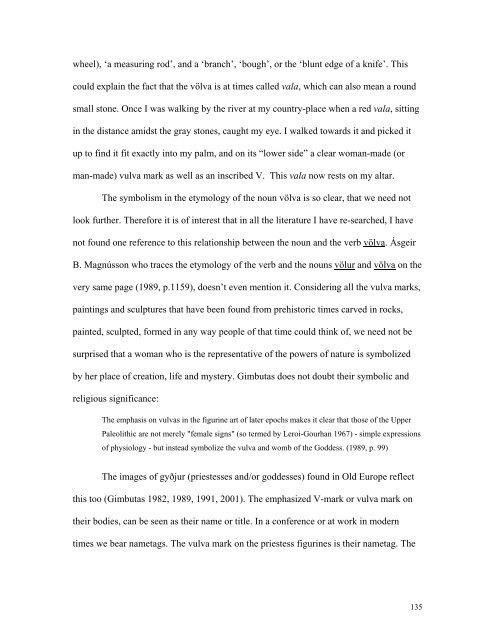You also want an ePaper? Increase the reach of your titles
YUMPU automatically turns print PDFs into web optimized ePapers that Google loves.
wheel), ‘a measuring rod’, <strong>and</strong> a ‘branch’, ‘bough’, or the ‘blunt edge <strong>of</strong> a knife’. This<br />
could explain the fact that the völva is at times called vala, which can also mean a round<br />
small stone. Once I was walking by the river at my country-place when a red vala, sitting<br />
in the distance amidst the gray stones, caught my eye. I walked towards it <strong>and</strong> picked it<br />
up to find it fit exactly into my palm, <strong>and</strong> on its “lower side” a clear woman-made (or<br />
man-made) vulva mark as well as an inscribed V. This vala now rests on my altar.<br />
<strong>The</strong> symbolism in the etymology <strong>of</strong> the noun völva is so clear, that we need not<br />
look further. <strong>The</strong>refore it is <strong>of</strong> interest that in all the literature I have re-searched, I have<br />
not found one reference to this relationship between the noun <strong>and</strong> the verb völva. Ásgeir<br />
B. Magnússon who traces the etymology <strong>of</strong> the verb <strong>and</strong> the nouns völur <strong>and</strong> völva on the<br />
very same page (1989, p.1159), doesn’t even mention it. Considering all the vulva marks,<br />
paintings <strong>and</strong> sculptures that have been found from prehistoric times carved in rocks,<br />
painted, sculpted, formed in any way people <strong>of</strong> that time could think <strong>of</strong>, we need not be<br />
surprised that a woman who is the representative <strong>of</strong> the powers <strong>of</strong> nature is symbolized<br />
by her place <strong>of</strong> creation, life <strong>and</strong> mystery. Gimbutas does not doubt their symbolic <strong>and</strong><br />
religious significance:<br />
<strong>The</strong> emphasis on vulvas in the figurine art <strong>of</strong> later epochs makes it clear that those <strong>of</strong> the Upper<br />
Paleolithic are not merely "female signs" (so termed by Leroi-Gourhan 1967) - simple expressions<br />
<strong>of</strong> physiology - but instead symbolize the vulva <strong>and</strong> womb <strong>of</strong> the Goddess. (1989, p. 99)<br />
<strong>The</strong> images <strong>of</strong> gyðjur (priestesses <strong>and</strong>/or goddesses) found in Old Europe reflect<br />
this too (Gimbutas 1982, 1989, 1991, 2001). <strong>The</strong> emphasized V-mark or vulva mark on<br />
their bodies, can be seen as their name or title. In a conference or at work in modern<br />
times we bear nametags. <strong>The</strong> vulva mark on the priestess figurines is their nametag. <strong>The</strong><br />
135


